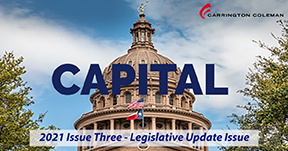With the rise in non-compete agreements throughout all business sectors, the inclusion of a non-compete in a physician’s agreement with a practicing group has also increased greatly. Non-competes that restrict a physician’s practice of medicine, however, uniquely impact general public health, and a patient’s individual health, more than non-competes in most other industries. While many non-competes are designed to protect a business’s confidential information and customers, physician non-competes are generally intended to prevent the doctor from continuing medical relationships with patients, a relationship typically thought of as more than just business. Therefore, Texas statute and case law impose additional burdens on the party attempting to restrict the activities of a physician pursuant to a non-compete agreement.
The requirements of the Texas Non-Compete Act, section 15.50 of the Texas Business and Commerce Code, for enforcement of a non-compete applies to all industries including physician non-competes. Therefore, under section 15.50(a), a physician non-compete will only be enforced if it: (1) is reasonable as to “time, geographic area and scope of activity to be restrained”; and (2) does “not impose a greater restriction than is necessary to protect the goodwill or other business interest of the promisee.”
Physician non-competes, however, face additional barriers to enforcement because of the circumstances surrounding the provision of healthcare. Therefore, a non-compete related to the practice of medicine must also comply with the provisions of section 15.50(b). Specifically, the law for physician non-competes requires that the agreement must permit the physician to “buy out” the non-compete at a “reasonable price” or it will not be enforced. TEX. BUS. & COM. CODE ANN. § 15.50(b)(2). The Texas Non-Compete Act also prohibits the contractual denial to the physician of a list of patients seen or treated in the last year before termination, and mandates access to medical records upon the patients’ authorization. TEX. BUS. & COM. CODE ANN. § 15.50(b)(1). Lastly, the non-compete must permit the physician to provide continuing care and treatment to patients during the course of an acute illness. TEX. BUS. & COM. CODE ANN. § 15.50(b)(3). Whether a non-compete meets these requirements, and is thus enforceable, is a matter of law for a court to decide. The burden is on the former employer seeking to enforce the restrictions.
Many disputes arise concerning whether the required “buy out” price contained in a physician non-compete is “reasonable,” as required by the statute. To determine whether this element has been met, courts often use an analysis similar to the determination of whether a liquidated damages provision is enforceable. Accordingly, the court will determine if the buy out price is reasonable by comparing it to an estimation of the employer’s forecasted lost profit if the physician were to violate the non-compete. Under this analysis, setting the buy out to be equal to the physician’s previous income, or to the yearly revenue generated by the physician, would be a mistake. Instead, the buy out provision should contain a price that reflects the anticipated net loss by the employer caused if patients follow the departing physician to another healthcare facility. If the parties’ wish to avoid determining the price of the buy out at the time of contracting, the statute allows for the amount to be determined through arbitration.
In addition to the unique buy out provision, the rules specific to physician non-competes prohibit key restrictions usually sought in other industries. For example, most non-competes are designed to prevent former employees from soliciting and obtaining the business of the employer’s customers. Accordingly, former employees are prohibited from retaining customer lists after their termination that would facilitate the easy solicitation of customers. But, in the healthcare context, not only does the statute require that the physician not be denied access to a patient list, but the physician is required by Texas Medical Board Rule 165.5 to send letters to all the patients treated in the last two years to notify them that the physician is no longer available. In addition, Texas Medical Board Rule 165.5 also requires the healthcare facility to post a similar written notice on its premises to alert patients that the physician has left its practice and further instructing patients where and how they can obtain their medical records. Therefore, while most businesses handle an employee’s termination in a manner designed to most effectively retain the customer’s business, when a physician relocates, the rules are designed to put the patients’ interests first.
More than other fields, courts factor in the impact to public policy when determining the enforceability of a physician non-compete. For example, the geographic area contained in the non-compete may be particularly scrutinized. If the non-compete would effectively eliminate a doctor from a city that needs healthcare providers, a court may determine that the restriction is overbroad as a matter of law. In addition, the breadth of the scope of activity prohibited may be subject to challenge. A clause that prevents a physician from generally practicing medicine within a certain radius of the prior place of employment may be overbroad and unenforceable if the physician only practices a certain type of medicine.
When drafting, enforcing, or defending non-competes for a physician, it is important to remember that while the same rules apply as to other fields, there are additional requirements to enforcement and additional concerns to consider. The healthcare industry is definitely a business in today’s economy, but the law still recognizes that it is different, and involves a type of relationship not typical in other areas that utilize non-compete agreements with its employees.
